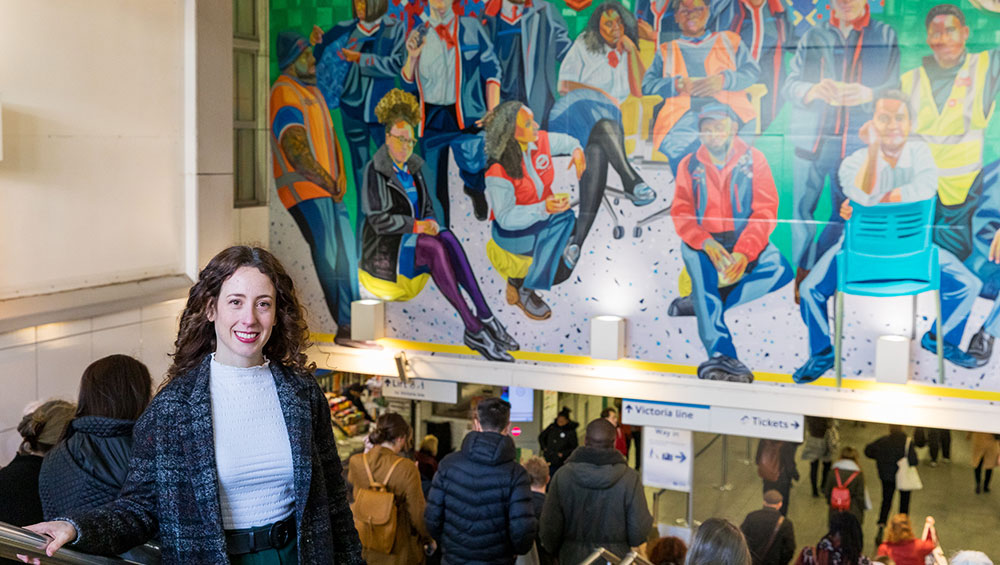
Aliza Nisenbaum. Photo: Benedic Johnson.
by JULIET RIX
Aliza Nisenbaum was born in 1977 in Mexico City and grew up there with her Scandinavian American artist mother, her Russian Jewish father who ran a leather goods business, and her younger sister. The family travelled widely, including to the UK and New York, visiting sights and exhibitions. Nisenbaum found early artistic inspiration in London and decided she eventually wanted to live in New York City. She studied psychology for two years in Mexico before taking up a place at the Art Institute of Chicago. Following her time as a student there, she stayed on to teach before finally moving to New York. Now resident in Harlem, she is a professor at Columbia University’s School of the Arts.
In 2012, Nisenbaum was asked by Tania Bruguera of Immigrant Movement International to teach English to undocumented migrants in Queens. Although she began the classes with no intention of painting her students, the experience led to a series of portraits of the migrants and their families and the development of the artistic process she has used ever since.
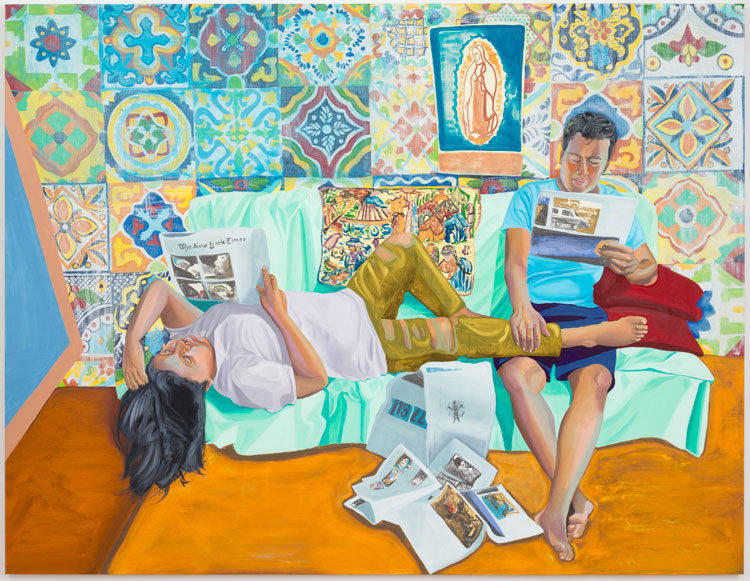
Aliza Nisenbaum. Las Talaveritas, Sunday Morning NY Times, 2016. Oil on linen, 88 x 68 in (223.5 x 172.7 cm). Courtesy the artist and Anton Kern Gallery, New York / © Aliza Nisenbaum.
Best known for her colourful portraits (single and group) of people not traditionally the subject of portraiture, Nisenbaum works from life, spending a long time with her sitters, talking and really getting to know them – a technique not best suited to the present pandemic.
In 2019, she spent several months in the UK, living in Brixton in south-east London and fulfilling a commission from Art on the Underground for a large group portrait of Transport for London staff at Brixton tube station.
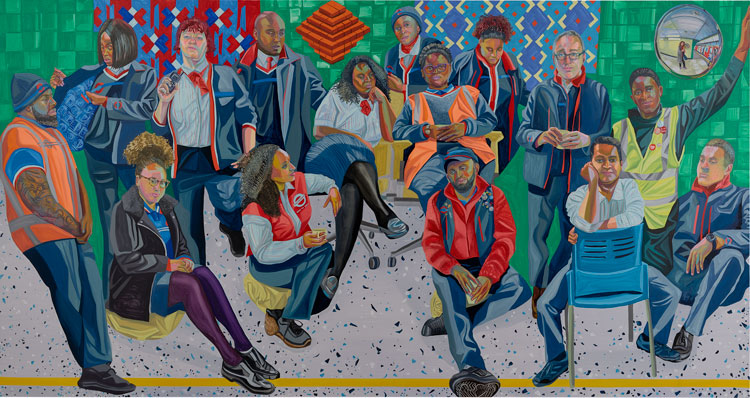
Aliza Nisenbaum. London Underground: Brixton Station and Victoria Line Staff, 2019. Oil on polyester, 74 3/4 x 142 1/8 in (190 x 361 cm). Courtesy the artist and Art on the Underground, London; Anton Kern Gallery, New York / © Aliza Nisenbaum.
Intending to return to Britain this summer to paint for the Tate show, Nisenbaum had taken leave from her teaching until January 2021 and was having a winter break in Los Angeles when the virus arrived. So, instead of being in Liverpool, she is grounded in LA, communicating on Zoom and adapting her working practice to the age of Covid-19.
Juliet Rix: What have you been working on? How has lockdown and the coronavirus affected your work?
Aliza Nisenbaum: My work has always been very much about sitting with people and painting them from life and, obviously, social distancing doesn’t permit that, so I’ve had to think differently and do more from memory and photographs. It’s really opened up my practice.
Since March, I’ve been taking walks around Los Angeles drawing the flowers and plants which, unlike those in New York, are very similar to the vegetation I grew up with in Mexico City. My mother was a flower painter and one of my earliest artistic influences was the Marianne North Gallery in London’s Royal Botanic Gardens at Kew, which I visited as a child with my parents. It is one of my favourite museums in the world and still influences the drawings I’m doing now.
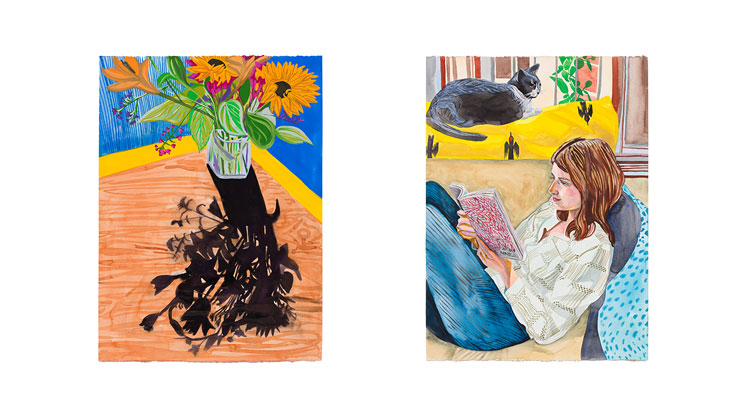
Aliza Nisenbaum. Sunflowers & Alex, 2020. Gouache and watercolour on paper, paper dimensions (each): 30 x 22 in
(76.2 x 55.9 cm). Courtesy the artist and Anton Kern Gallery, New York / © Aliza Nisenbaum.
I’ve been making large-scale drawings of the plants and then painting and pairing them with people I’m thinking of in New York, or friends, students or models I’ve painted before. I have a show planned in the fall at Anton Kern Gallery of these diptychs of people with flowers – it’s like sending them flowers in a way.
I have been quite anxious during the pandemic. A lot of the people I’ve painted are undocumented migrants in Queens, NYC – in the district of Corona (like the virus!), which was the epicentre of the pandemic for a while. So, I was thinking of some of the people I painted there and making drawings of them and being in touch with them to see how they were doing. Thankfully, although they have been very affected financially, they are all healthy.
JR: What was the plan for the Liverpool show?
AN: The original plan was to paint people on that very British thing – their allotments. The intention was to continue my interest in assembly and how different communities come together. Since the coronavirus, I’ve been inspired by how that has completely changed. We’re all on Zoom and, in Italy and New York, people were assembling on their balconies and clapping for care workers. Things have really shifted around in how we assemble.
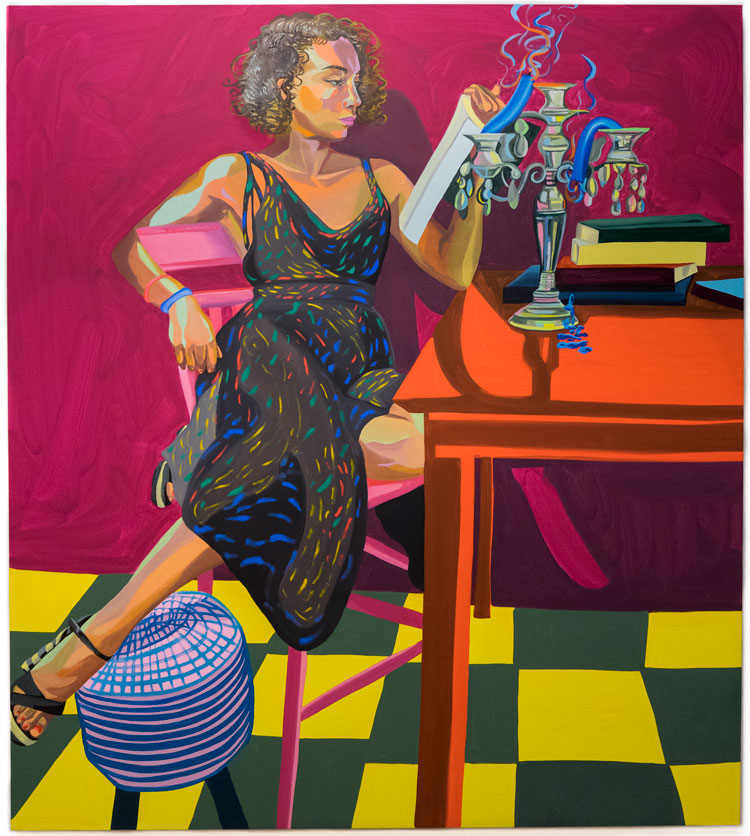
Aliza Nisenbaum. Jenna, Friday Night in Brooklyn, 2019. Oil on canvas, 64 x 57 in
(162.6 x 144.8 cm). Courtesy the artist and Anton Kern Gallery, New York / © Aliza Nisenbaum.
My last exhibition – in New York, in fall 2019 – was very much about assembly. I did some paintings of salsa dancers. I really love going salsa-dancing so I was thinking about how Latino communities come together in salsa clubs. I’d go dancing and then ask people if they’d sit for me. I painted the workforce at the gallery, too. From the owner to the cleaners, I made a big portrait of everyone. It was my first show at Anton’s so I got to know everyone because I sit with people and paint them over an extended period and that allows for a very intimate conversation. I also displayed the painting I did in the UK earlier in the year, the group portrait of tube workers in Brixton, so there were three very different communities shown together and brought into dialogue with each other in the gallery.
A few years ago, I painted a group of women in a Minneapolis community education garden. It was really interesting to paint them in this space that was all about food justice, and that started me thinking about the way Europeans have allotments, so I was going to paint people on their allotments in Liverpool.
JR: How has that plan changed now that you won’t be travelling there?
AN: The pandemic started me thinking about making paintings of keyworkers and first responders, to humanise them and put a face to the people who have been working so hard during this crisis. It has really changed our sense of what is an essential worker. Sometimes they’re deemed low-skilled workers – such as people who work in supermarkets – but they have proved crucial to our survival.
I obviously can’t paint them from life, so, after all these Zoom meetings, I proposed to do the work remotely. A professional photographer will take many different photographs of the individuals in Liverpool and then I will do Zoom meetings with each one that I will be painting. It will be the first time I have done sittings via Zoom. I won’t paint on Zoom. I will talk to them on Zoom, then paint from the photographs – and from invention inspired by the sense of the person I get from the Zoom meetings.
We have put out an open call to people who work at Liverpool’s Royal Hospital and at [Alder Hey] children’s hospital. I’ve already received quite a few applications. One woman is a chaplain at the hospital, who is there for people at difficult moments. Another woman says her children beg her not to go to work every day because she is putting herself at risk. And there’s a man who makes awards for all the children that come into hospital with their favourite superhero and favourite colour. The stories have been quite moving.
JR: Is it going to be hard to choose who to paint?
AN: I think it’s going to be really hard, but I’m going to be making a lot of drawings as well so, hopefully, I can include as many people as possible. I’ll be making a big painting of the hospital workers with maybe 10 of them, and another one of the supermarket staff, as well as individual drawings.
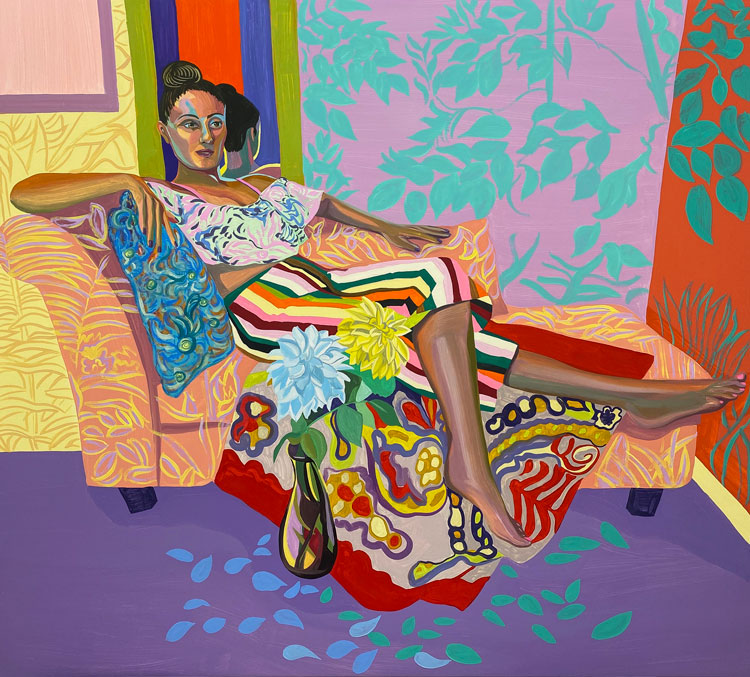
Aliza Nisenbaum. Tumbao de Omambo, 2020. Oil on canvas, 57 x 63 in (144.8 x 160 cm). Courtesy the artist and Anton Kern Gallery, New York / © Aliza Nisenbaum.
Usually, the models respond to me in real time as they see how I start painting their faces. I paint in a faceted way, small planes of colour next to each other showing the different temperature of skin. I think I’ll be able to capture that from photography as well. This is pretty much the crux of my work. The way I paint my sitters is quite intimate. You have to pay close attention to the subtle nuance of every little character in their face, and colour is something that is very contingent. Everyone perceives it differently and it’s a myth that even within a particular race there’s a seamless colour. To me, that’s like a metaphor of how nuanced identity is. We’re very multifaceted in terms of our identities. I’m Mexican, white, with parents from America and Russia. My father’s family fled the pogroms and ended up in Mexico City. I feel like my own identity is pretty complex.
A philosopher I really love is Emmanuel Lévinas, who said that another’s face is something you can never fully understand so it elicits an ethical demand because you never truly know the interiority of an individual. You can empathise and sympathise, but you can never put yourself fully in another person’s situation.
JR: You must have had some interesting conversations with your sitters?
AN: Yeah. When I was in Brixton it was after the vote for Brexit so quite a few people who sat for me told me their political views. Some were pro-Brexit, some anti, and sitting with them you have to calibrate your relationship to each other. Mostly I have really wonderful experiences, but sometimes, obviously, I have very different political views from somebody I’m sitting with. I feel like the way we find common ground is through our bodies, thinking about the weight of another person’s body, their materiality, is like a starting part. They might be telling me something that’s difficult politically, but I can see through their body language what it might mean to them.
People often surprise me. I had one person in Brixton telling me all about the Louvre. They knew so much about art history and they were saying that the art in the Louvre is the history of white people. I’ve had undocumented immigrants here in the US who work really long hours and then run the Boston marathon. People’s lives are so layered. I had one woman singing – serenading me – all the time I was painting, which was so much fun. I sometimes ask people about the music they like and use my Spotify to play it while they are sitting. I only paint their faces while they are with me, so I sometimes also use the music as a soundtrack while I paint their clothing and finish the picture after they’ve gone.
One man I painted in Brixton suddenly started to weep and said: “I’m going to go down in history because of this painting.” That was so nice.
The connection with sitters is a very interesting part of the work – and very much outside my control. It’s unpredictable what somebody’s going to bring to a sitting.
JR: Is all that going to work on Zoom?
AN: I’ve found Zoom to be surprisingly intimate. It’s not the same as face-to-face but you can get very close to a person. At first, I was very opposed to Zoom but, even though you don’t have all the body cues, you still get quite a bit of a person’s personality.
JR: Does what people say to you change how you paint them?
AN: Yeah. Oftentimes, they are also looking at the painting while I’m painting, which actually makes me quite anxious that they’ll be happy with it, that I’ll do them justice. They’ll even look at the colour I paint their lips and be like, oh no, please make it pinker or less bright or something. They have a say in it sometimes. And the backgrounds of my paintings are also an extension of the people’s personality, their biography. The places I paint people in are not realistic, they are a montage of points in time.
In Minneapolis, I painted these guards who liked a particular baseball team, so I painted them in the background, and in Brixton I put in the station tiles and the pins [badges] they wear. In Las Talaveritas, Sunday Morning, NY Times [2016], the background is the mosaics from the town this family is from in Puebla in Mexico, even though at the moment they find themselves in New York.
JR: Will you be doing something similar with the Liverpool work?
AN: Yes, in this case I am going to ask them for the books that have helped them ride this crisis, or some people have already written that they love music, and one is a yoga teacher on the side. I don’t know what shape the background will take until I talk to the people.
JR: Your work could be summed up – if rather simplistically – as people and patterns, and the patterns do feel like a crucial part of the work not only visually but also in terms of content. Where does that come from?
NA: I grew up in Mexico in a family that really loved textiles and our house was the opposite of minimalist – it was maximalist. We used to go to Xochimilco market, an amazing remnant of the floating gardens of Hispanic times and my mother would fill the car with plants. There’s such a rich tradition of craftwork in Mexico and all these textiles in the markets.
I love the intimist painters such as Pierre Bonnard and Édouard Vuillard, who envelop their subjects in very rich interiors. For me, it’s a way of enveloping, even embracing my subjects in richness.
JR: Tell me about the background you have chosen for yourself. Behind you on Zoom is a large line drawing?
AN: It’s a drawing by María Izquierdo. She was painting small easel paintings in the time of the great Mexican muralists, Diego Rivera, José Clemente Orozco and David Alfaro Siqueiros, in the 1920s and 30s. It’s a preparatory drawing for a mural she was commissioned to do that would have been the first large-scale muralist work by a woman. Rivera was her teacher and an early supporter of hers, but when the government of Mexico asked her to do this mural, Rivera and the other powerful male artists vetoed her and said she wasn’t up to it and was just a female easel painter.
I keep this drawing on my Zoom background to think about the potential of muralism at the time and how she was never allowed to make this one.
JR: The position of female artists has improved, hasn’t it?
AN: Mmm, yeah, not so much. Since that time, of course it has got better, but not enough. I still feel the collecting of female artists is not proportionate, and women’s voices are still not always heard.
JR: You work so closely with your sitters. How can you be sure you will feel empathy for the people you choose to paint?
AN: I usually talk to people quite a bit beforehand, so the people I end up painting are people I can spend up to five hours with. Talking is also a way of making them feel comfortable. Usually, I mix a ton of colours before they arrive, then when they come, before I start staring at them, I kind of rearrange the mixing, adding a bit of warm or a bit of cool. It’s a way of lulling them into the process because it’s quite intense as I look at every little expression and fold in the skin closely and we’re in close proximity.
It can also help for them to do something else while I paint. They can be reading or having a snack or watching a film. I don’t need them to look me in the eyes until I paint the eyes at the very end.
JR: That really isn’t a way of working that is very compatible with the pandemic is it?
AN: No, and it certainly wouldn’t work with a mask! I think that, for some of the people who have been on the front line of the pandemic, it could be quite a relief to talk about some of their feelings about it.
JR: That could get really quite intense. You studied psychology, so are you prepared for this?
AN: I think it is the least I can do. I think it will be OK. Sometimes I think you just need to hold space for people. Occasionally when I paint people, even from life, it doesn’t go so well when they are there and, after an hour, I’ll say thank you very much and I’ll complete the painting from a photograph. I need the interaction and getting to know them, in life or on Zoom, to motivate me and to interpret. It raises the bar of what I have to do – but I don’t necessarily need them there all the time.
JR: What else have you been doing in lockdown?
AN: I’ve been active with Black Lives Matter here in Los Angeles. It’s interesting the confluence of the two things: one of the first global shared experiences we’ve had in decades, where the whole world is experiencing this vulnerability, and at the same time this super-exciting moment of social change here in the United States.
There’s so much to do. With Trump, alliances have become so fractured and we have to think how to bring those back. And it feels endless, the amount of work you need to do as a white person to become aware of your bias and really be in solidarity. I’m on this board in New York at the Cue Art Foundation, on a taskforce for shifting the institution towards justice in regard to BIPOC [black, indigenous, and people of colour] – making it more accountable at all levels and looking at how we can bring about change. The language of equity, diversity and inclusion is changing so much. I work in representation – in painting – but representation is not enough any more. There needs to be structural change in terms of capital and really lifting a whole community out of the margins.
JR: Do you feel that, through your work, you are in a way giving voice to the people you are painting?
AN: I hope so. I hope my work pays attention and gives tribute, and I have also spoken to my gallery about profit-sharing with either the sitters or with organisations such as the NHS, as an important aspect of my work from now on. I feel it’s so hard to see the individuals behind the numbers, such as the healthcare workers putting their lives on the line. But when you see their face, their hobbies, what they might be reading, you see them as fully fledged individuals.
That’s also why video is important as a complement to my work. With each community I work with, we’ve made a short film to document the process. We might even document some of the Zoom meetings I have with sitters. In the gallery in Liverpool, each project I’ll be showing – the Minneapolis painting, the Brixton painting and the new Liverpool work – will be accompanied by a short film bringing in the sitters in their own voices, their own words.
JR: When you are having these conversations do you think being female helps or hinders?
AN: I think it really helps.
JR: Why? In what way?
AN: This way of working with communities came about from the class I taught for Tania Bruguera. I said I’d teach English if I could do it for a group of women through feminist art history. It became a very safe space for the migrant women to talk about their experience. I’d take these mostly undocumented migrants, mainly from Mexico and Central America, to the Met, and art became a springboard to talk about all sorts of other things. And that eventually led to the portraits. After that volunteer activity, I saw painting almost as a technique to get to know people, particularly a way of being face-to-face with people with whom I wouldn’t otherwise be so in touch. People usually like having themselves depicted and that allows for a process that brings more than just representation. I hope that is disclosed through the work, through the fleshing out of those personalities.
JR: Do you enjoy teaching?
NA: I love teaching. I’ve been teaching for almost 15 years at so many different types of institution and with different kinds of students. They are my friends now. I still have students from my first class at the Art Institute of Chicago, some of them now very successful artists, whom I may turn to for advice on my work as well. During the pandemic in LA, I’ve gone on socially distanced hikes with some of my former students.
When I am painting models, I think about the idea of listening with hospitality. These relationships are different from most, almost like a gift economy. They are giving you their image. Even though you are paying them by the hour, it becomes more than that. And I feel like teaching is like that, too; a relationship that is not tied by family or work. It’s a very special type of relationship.
JR: It sounds as though you, as well as the students, get a lot out of it?
NA: Yes, I feel my students raise the bar on what I have to do. They keep me up to date in terms of ideas. And painting is such an anachronistic thing – a world on its own – and I go into their studio and they tell me about the paint they are excited about or even a different medium. It was through teaching that I learned about social practice – art that has a social purpose. I was a painters’ painter, very interested in colour and the paint itself, but also, since I was young, I had interests in and worked with community and activism. It took a while, but I finally brought the two together.
• Aliza Nisenbaum is at Anton Kern, New York, 9 September to 24 October 2020, and at Tate Liverpool, 15 December 2020 to 27 June 2021. For Tate, timed tickets must be booked in advance.